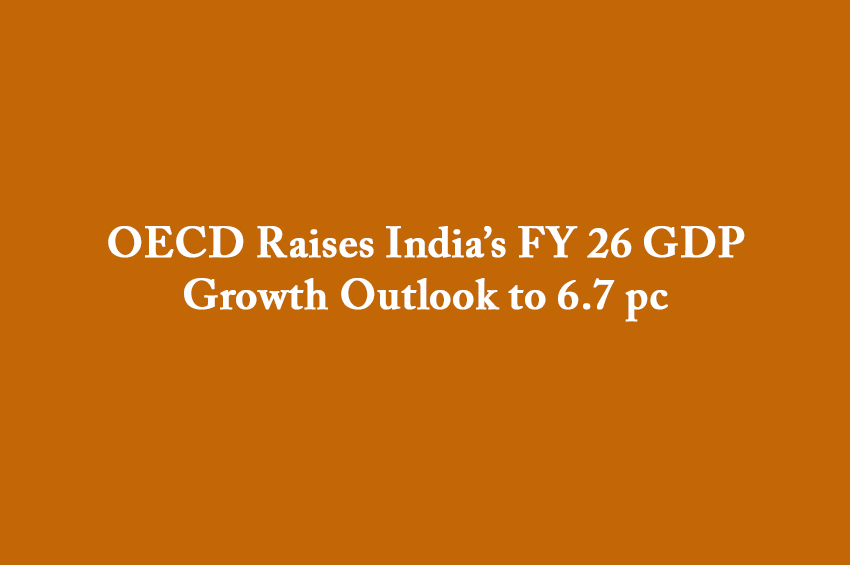Winning Bizness Economic Desk
India’s economy will expand faster this fiscal (FY 26) than previously expected with the Organisation for Economic Co-operation and Development (OECD) upping its annual forecast by 40 basis points (bps) to 6.7 per cent.
This increase has been done on the back of monetary and fiscal easing, along with the cuts recently effected in the Goods and Services Tax (GST).
“In India, high tariff rates will weigh on the export sector but overall activity is anticipated to be supported by monetary and fiscal policy easing, including reform to the GST,” the OECD said in its interim outlook released early this week.
OECD is, however, not very upbeat on the following year, lowering its FY 27 projection to 6.2 per cent from 6.4 per cent.
The country’s GDP growth rose by 7.8 per cent in the first-quarter (Q1 FY 26), its fastest pace in five quarters. It is now expected that the momentum will remain strong during the second-quarter (Q2) as well.
On the inflation front, the OECD’s assessment has offered good news—it pegs consumer prices at an average 2.9 per cent in FY 26, a sharp slide from the earlier forecast of 4.1 per cent and staying near three per cent during FY 27.
Here, a point to note is that the projection aligns with recent data showing retail inflation being below three per cent for four straight months.
The global outlook, however, seems to have improved as OECD projected the global economy to increase 3.2 per cent as compared with the earlier projection of just 2.9 per cent.
Panel Approves Hydropower Project in Arunachal Pradesh
The expert panel of the Union Environment Ministry has recommended environmental clearance for the 2,220 MW Oju hydroelectric project in Arunachal Pradesh Subansiri Valley, as per the minutes of the panel’s September 12 meeting.
This will be the country’s third-largest hydel project to get a green approval after the 3,087 MW Etalin project and the 2,880 MW Dibang project. All the three projects are being built in the north-eastern state.
In fact, the Etalin project which is being executed by the state-run SJVN Ltd was granted approval by the environment ministry’s Expert Advisory Committee (EAC) on July 30 this year.
The 2,220 MW hydroelectric project will be located in the remote area of Upper Subansiri district in Arunachal Pradesh.
What needs highlighting here is that it will utilise the flow of the Subansiri river for generation of electric power. It will also have a significant gross storage of 15.66-Million Cubic Metres (MCM).
The project will be built at a cost of Rs 24,942.01-crore and is likely to be completed in about five-years. It is being executed by Oju Subansiri Hydro Power Corporation Pvt Ltd.
Tremendous Potential for Hydropower in Arunachal Pradesh
The north-eastern state of Arunachal Pradesh has an exploitable hydropower potential of 50,394 MW which is 38 per cent of the country’s total hydel potential of 1,33,410 MW.
Apart from Etalin and Dibang hydel power projects, the government is also building the 2,000 MW Subansiri hydro project. This is likely to be commissioned by next year (May 2026).
A point to note here is that additionally there are a number of smaller projects such as the Heo Hydro Electric Project (240 MW) and the Tato-1 Hydro Electric Project (186 MW) of NEEPCO. The last named is a wholly-owned subsidiary of NTPC Ltd.
The government is also planning a mega hydel project of 11,000 MW Siang Upper Multipurpose Project (SUMP) in Arunachal Pradesh as a means to counter a 60,000 MW hydropower project being built by China on the Yarlung Tsangpo river in Tibet (called the Brahmaputra river in India) near Gelling in Arunachal Pradesh.
However, the 11,000 MW project has been stuck for a decade due to opposition from local communities and it is yet to reach the environment clearance stage.
A point to highlight here is that developing projects in Arunachal Pradesh supports the country’s clean energy transition and strengthens energy security.
Simultaneously, ramping-up hydropower in this border state (it borders China) also brings with it a geo-political dimension as it helps strengthen India’s presence along the frontier with China.
Additionally, it also boosts infrastructure and local development in the state.
Presently, the installed hydropower capacity in Arunachal Pradesh is a very low 1,256 MW.
Maharashtra City Emerging as India’s EV Hub: Fadnavis
Maharashtra state’s chief minister Mr Devendra Fadnavis has said that Chhatrapati Sambhajinagar is rapidly emerging as India’s electric vehicle (EV) manufacturing capital.
This is supported by large-scale investments and strategic infrastructure projects, he added.
The Maharashtra chief minister was speaking at the Marathwada Liberation Day, where he said that the region’s connectivity through the Nagpur-Mumbai Samruddhi Highway and the Delhi-Mumbai Industrial Corridor (DMIC) had made it a preferred destination for industries.
According to Mr Fadnavis, the Aurangabad Industrial City (Auric) has already attracted potential investments worth over Rs 71,000-crore in six-years.
Here, it must be pointed out that Auric is a greenfield industrial area at Shendra-Bidkin and is being developed as a part of the DMIC. It is expected to create in excess of 62,000 direct and indirect jobs.
Indian Tourist Numbers to Azerbaijan Dwindle Drastically
Indian tourists are not just avoiding Turkey but also its and Pakistan’s ally Azerbaijan as well. Indian travellers have drastically reduced tours to Azerbaijan after Operation Sindoor in May of this year.
According to official tourism data, the number of Indian tourists visiting Azerbaijan in June of this year slipped by two-thirds as compared to the same period last year (2024).
This is a steep slide indeed following Operation Sindoor and mirroring the trend seen with Turkey.
The figures stated by a leading news outlet reveal that only 9,934 Indian tourists visited Azerbaijan in June this year, as against the 28,315 tourists in the year-ago month.
This is a big southward slide, almost a 66 per cent plunge in India tourist arrivals following Operation Sindoor and Azerbaijan’s support to Pakistan during the Indo-Pak war.
An important point to note here is that it is the two months of May and June that are the peak months for Indian tourists visiting Azerbaijan. In May, 23,326 Indian tourists visited that country.
However, this was followed by a steep slide in June, with only 9,934 tourists from India. This, as mentioned before, is a steep drop of 66 per cent.
Last year (2024), Indian arrivals into Azerbaijan reached 2,43,589, a 108 per cent increase as compared to 1,17,312 arrivals in the previous year (2023).
The point that requires highlighting here is that during Operation Sindoor, only Turkey and Azerbaijan openly supported Pakistan.
Retailers Assn CEO Says Festival Sales Growth Could Cross 10 pc
India’s retail industry could be in for a very good time this festive season with growth likely to breach the double-digit threshold of ten per cent, the CEO of Retailers Association of India (RAI) Mr Rajagopalan said.
“It has gone to eight per cent levels and we’d love for it to become ten per cent as days go by,” Mr Rajagopalan told a leading news outlet.
According to the RAI CEO, early celebrations this year could further propel demand.
Retail sales in July increased eight per cent, marking the third straight month of higher momentum.
Mr Rajagopalan said that the value and mid-segment retailers who were under pressure for the past two years were finally witnessing an uptick, while premium continued to perform strongly.
“There is definitely an uptick,” he said, highlighting that this was good news as for the last two years, there was not enough consumer demand in the value segment of the retail market.
Mr Rajagopalan also spoke about the recent GST cuts initiated by the government. These cuts have only had a mixed impact on discretionary categories such as garments and footwear.
While products priced below Rs 2,500/- are cheaper, those above this price have an 18 per cent GST which Mr Rajagopalan called a “bit of a dampener”.
Jewellery demand was also shifting with consumers revealing more preference for design and demand-studded pieces over pure gold and silver due to high prices.
An important point to note here is that in weddings, premium buyers are expected to continue spending but mid-segment buyers may downsize, opting for 18-to-20 carat jewellery or smaller ticket items.
Interestingly, consumer durables are showing a mixed trend. Television sets and appliances could benefit from lower prices, but mobile phones remain costlier as GST rates have not been reduced.
Mr Rajagopalan said that white goods demand is “a mixed bag” with early signs of traction only in select categories.


